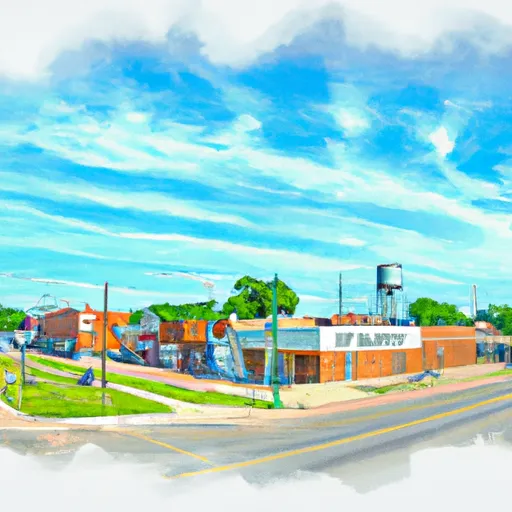-
 Snoflo Premium
Snoflo Premium
Get unlimited access to all our content
With no Ad interruptions! - Start Your Free Trial Login with existing account
Verden
Eden Index
Climate
8.3
•
Recreation
1.7
•
Community
1.1
•
Safeguard
4.2/10

Verden is a small town located in Grady County, Oklahoma. The climate in Verden is classified as humid subtropical, characterized by hot summers and mild winters. Average high temperatures reach around 95°F (35°C) in the peak of summer, while winter temperatures drop to around 50°F (10°C). Precipitation is moderate throughout the year, with an average annual rainfall of about 34 inches (86 cm).
The hydrology constituents of Verden primarily revolve around the nearby Washita River, which runs to the south of the town. The river provides opportunities for fishing, boating, and other water-based activities. Additionally, Verden is surrounded by beautiful natural landscapes, including farmland, rolling hills, and small lakes, which offer scenic views and opportunities for outdoor recreation such as hiking, birdwatching, and photography.
Verden also boasts several parks and recreational areas, including the Verden Lake and Park, which provides a tranquil setting for picnicking, walking trails, and fishing. The town's proximity to the Washita National Wildlife Refuge adds to the outdoor recreation opportunities, offering opportunities for wildlife viewing, hunting, and nature photography. With its pleasant climate, variety of outdoor activities, and natural beauty, Verden provides a welcoming environment for nature enthusiasts and those looking to enjoy the great outdoors.
What is the Eden Index?
The Snoflo Eden Index serves as a comprehensive rating system for regions, evaluating their desirability through a holistic assessment of climate health, outdoor recreation opportunities, and natural disaster risk, acknowledging the profound impact of these factors on livability and well-being.
Climate Health Indicator (CHI): 8.3
Verden receives approximately
842mm of rain per year,
with humidity levels near 80%
and air temperatures averaging around
16°C.
Verden has a plant hardyness factor of
7, meaning
plants and agriculture in this region tend to thrive during the non-winter months.
By considering the ideal temperature range, reliable water supplies, clean air, and stable seasonal rain or snowpacks, the Climate Health Indicator (CHI) underscores the significance of a healthy climate as the foundation for quality living.
A healthy climate is paramount for ensuring a high quality of life and livability in a region, fostering both physical well-being and environmental harmony. This can be characterized by ideal temperatures, reliable access to water supplies, clean air, and consistent seasonal rain or snowpacks.
Weather Forecast
Streamflow Conditions
Washita
Area Rivers
Washita
Snowpack Depths
Washita
Reservoir Storage Capacity
Washita
Groundwater Levels
Recreational Opportunity Index (ROI): 1.7
The Recreational Opportunity Index (ROI) recognizes the value of outdoor recreational options, such as parks, hiking trails, camping sites, and fishing spots, while acknowledging that climate plays a pivotal role in ensuring the comfort and consistency of these experiences.
Access to outdoor recreational opportunities, encompassing activities such as parks, hiking, camping, and fishing, is crucial for overall well-being, and the climate plays a pivotal role in enabling and enhancing these experiences, ensuring that individuals can engage in nature-based activities comfortably and consistently.
Camping Areas
| Campground | Campsites | Reservations | Toilets | Showers | Elevation |
|---|---|---|---|---|---|
| Lake Chickasha | 50 | 1,207 ft | |||
| Taylor Lake | 20 | 1,289 ft | |||
| Randlett Park | None | 1,192 ft | |||
| Kiowa Park - Waurika Lake | None | 979 ft | |||
| Hapgood RV Park | 12 | 881 ft | |||
| Moneka Park - Waurika Lake | None | 906 ft | |||
| Wichita Ridge - Waurika Lake | None | 1,001 ft | |||
| Chisolm Trail Ridge - Waurika Lake | None | 975 ft |
Nearby Ski Areas
Catastrophe Safeguard Index (CSI):
The Catastrophe Safeguard Index (CSI) recognizes that natural disaster risk, encompassing floods, fires, hurricanes, and tornadoes, can drastically affect safety and the overall appeal of an area.
The level of natural disaster risk in a region significantly affects safety and the overall livability, with climate change amplifying these risks by potentially increasing the frequency and intensity of events like floods, fires, hurricanes, and tornadoes, thereby posing substantial challenges to community resilience and well-being.
Community Resilience Indicator (CRI): 1.1
The Community Resilience Indicator (CRI) recognizes that education, healthcare, and socioeconomics are crucial to the well-being of a region. The CRI acknowledges the profound impact of these elements on residents' overall quality of life. By evaluating educational resources, healthcare accessibility, and economic inclusivity, the index captures the essential aspects that contribute to a thriving community, fostering resident satisfaction, equity, and social cohesion.

